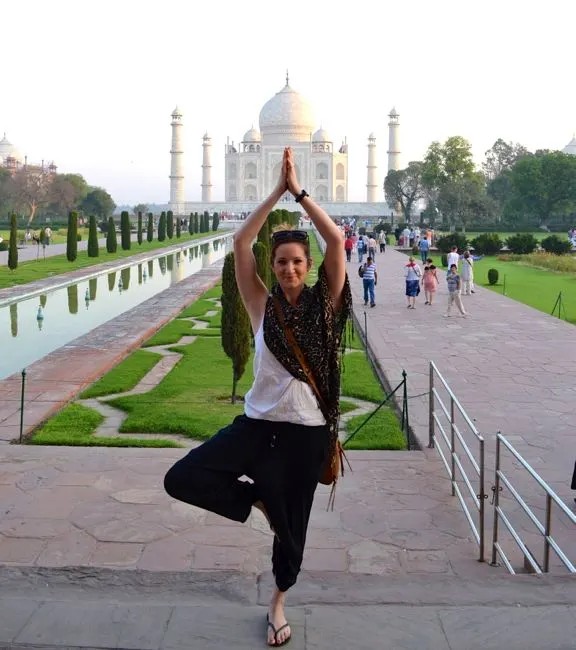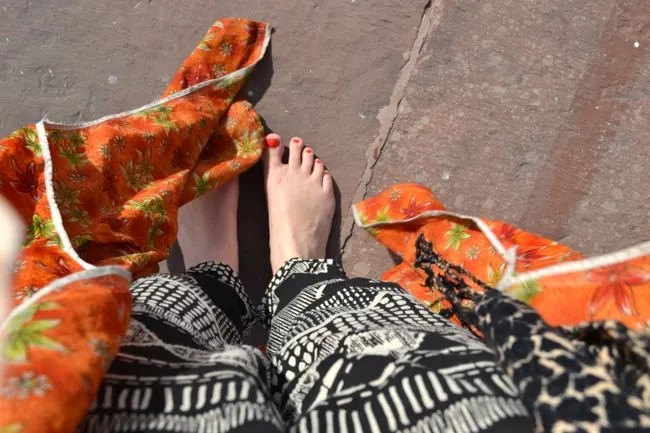Planning a trip to India and wondering what to pack? TRAVELS.EDU.VN understands the challenge of balancing comfort, cultural sensitivity, and style. Let us help you navigate the packing dilemma and ensure you’re prepared for an unforgettable Indian adventure by providing expert advice on travel apparel, suitable clothing, and fashion advice.
India’s climate and cultural norms require careful consideration when choosing your wardrobe. This guide provides insights into selecting the best clothing to respect local customs while staying comfortable in the diverse climate, with tips for cultural appropriateness, weather considerations, and versatile outfit choices.
1. Understanding India’s Climate and Cultural Norms
India is a land of diverse climates, ranging from the hot and humid coastal regions to the cooler, mountainous areas. Culturally, it’s a relatively conservative country, particularly when it comes to women’s attire. Understanding these factors is crucial for packing appropriately.
1.1. Climate Considerations
India experiences distinct seasons, each requiring different clothing choices.
- Summer (March to May): Expect intense heat, especially in the northern plains. Lightweight, breathable fabrics are essential. Temperatures can soar to 113°F (45°C) or higher.
- Monsoon (June to September): High humidity and heavy rainfall prevail. Quick-drying fabrics and waterproof outerwear are recommended. Mumbai, for instance, receives an average of over 70 inches of rain during this period.
- Winter (October to February): Pleasant and mild temperatures, particularly in the south. Layering is ideal as temperatures can vary significantly between day and night. Delhi can experience temperatures as low as 41°F (5°C) in December and January.
1.2. Cultural Sensitivity
While attitudes are evolving, dressing modestly is still highly valued in many parts of India. This is especially important when visiting religious sites or rural areas.
- Respectful Attire: Avoid clothing that is too revealing, such as low-cut tops, short skirts, and tight-fitting garments.
- Shoulders and Knees: Covering your shoulders and knees is generally a good practice.
- Religious Sites: Many temples and mosques require visitors to cover their heads. Always carry a scarf for this purpose.
2. Essential Clothing Items for India
Based on the climate and cultural considerations, here’s a comprehensive packing list for your trip to India.
2.1. Loose and Breathable Trousers
Opt for lightweight, loose-fitting trousers made from cotton, linen, or rayon. These fabrics are breathable and will keep you cool in the heat. Choose darker colors like navy, black, or brown, as they tend to hide dirt better.
- Fabric Options: Cotton, linen, rayon blends
- Style Tips: Palazzos, harem pants, or wide-leg trousers are excellent choices.
- Benefits: Comfortable, culturally appropriate, and versatile.
 Loose fitting pants for Indian travel
Loose fitting pants for Indian travel
2.2. Modest Tops and T-Shirts
Pack several plain, loose-fitting t-shirts and tops. Again, cotton or linen are ideal. Avoid tops with low necklines or that expose your midriff.
- Color Palette: Neutral colors like white, gray, and black are versatile and easy to mix and match.
- Sleeve Length: Short sleeves are generally acceptable, but consider bringing a few tops with longer sleeves for more conservative settings.
- Quantity: Aim for 5-7 tops for a two-week trip.
2.3. Long Skirts and Dresses
Long skirts and dresses that fall below the knee are excellent options for India. They are comfortable, stylish, and culturally appropriate.
- Fabric Choice: Cotton, rayon, or silk blends work well.
- Style Suggestions: Maxi dresses and A-line skirts are both flattering and practical.
- Bonus: Easy to dress up or down with accessories.
 Long black cotton dress for travel
Long black cotton dress for travel
2.4. Cover-Ups and Light Jackets
A light jacket or cover-up is essential for cooler evenings or when visiting religious sites. A shawl, cardigan, or lightweight denim jacket are all great options.
- Versatility: Choose a neutral color that can be paired with multiple outfits.
- Material: Opt for breathable fabrics like cotton or linen.
- Functionality: Provides warmth and modesty when needed.
2.5. Comfortable Footwear
Comfortable shoes are a must, as you’ll likely be doing a lot of walking. Consider bringing a pair of sandals or flip-flops, as well as a pair of closed-toe shoes for more rugged terrain.
- Sandals: Choose durable sandals with good arch support. Brands like Teva and Birkenstock are popular choices.
- Closed-Toe Shoes: Lightweight sneakers or walking shoes are ideal for exploring cities and historical sites.
- Evening Shoes: If you plan on going out in the evenings, pack a pair of dressier sandals or flats.
2.6. Scarves and Shawls
A scarf is one of the most versatile items you can pack for India. It can be used to cover your head in religious sites, protect yourself from the sun, or add a pop of color to your outfit.
- Fabric: Lightweight cotton or silk scarves are ideal.
- Size: Choose a large scarf that can be easily draped over your head and shoulders.
- Uses: Head covering, sun protection, modesty, and accessory.
 Woman wearing a scarf for modesty
Woman wearing a scarf for modesty
2.7. Accessories
Accessories can help you personalize your outfits and add a touch of style.
- Jewelry: Pack a few pieces of simple jewelry that can be worn with multiple outfits.
- Sunglasses: Essential for protecting your eyes from the strong Indian sun.
- Hats: A wide-brimmed hat can provide extra sun protection.
3. What NOT to Wear in India
To ensure you are respectful of local customs and comfortable in the Indian climate, here are some items to avoid packing:
- Revealing Clothing: Avoid low-cut tops, short shorts, and mini skirts.
- Tight-Fitting Clothes: Opt for loose, breathable fabrics instead of tight jeans or leggings.
- Expensive Jewelry: Leave your valuable jewelry at home to avoid unwanted attention.
- High Heels: Stick to comfortable footwear, as you’ll likely be doing a lot of walking.
4. Specific Clothing Recommendations Based on Location
India is a vast country, and the appropriate attire can vary depending on the region you’re visiting.
4.1. Northern India (Delhi, Rajasthan)
This region experiences extreme temperatures, with hot summers and cold winters.
- Summer: Lightweight cotton clothing, hats, and sunglasses are essential.
- Winter: Pack warm layers, including sweaters, jackets, and scarves.
- Modesty: Dress modestly, especially when visiting religious sites.
4.2. Southern India (Kerala, Tamil Nadu)
The climate in Southern India is generally hot and humid year-round.
- Lightweight Fabrics: Opt for breathable fabrics like cotton and linen.
- Rain Protection: Bring a raincoat or umbrella, especially during the monsoon season.
- Beachwear: If you’re visiting coastal areas, pack modest swimwear.
4.3. Goa
Goa is known for its relaxed beach culture, but it’s still important to dress respectfully when away from the beach.
- Beach Attire: Swimsuits and beachwear are acceptable on the beach, but cover up when visiting temples or towns.
- Light Clothing: Pack lightweight, breathable clothing for the hot and humid climate.
- Evening Wear: Bring a few dressier outfits for evenings out.
4.4. Mumbai
Mumbai is a cosmopolitan city, but it’s still important to dress modestly, especially in more traditional areas.
- Business Attire: If you’re traveling for business, pack professional clothing that is appropriate for the climate.
- Casual Wear: Opt for lightweight, breathable clothing for everyday wear.
- Rain Protection: Mumbai receives heavy rainfall during the monsoon season, so bring a raincoat or umbrella.
5. Packing Tips for India
Here are some additional tips to help you pack efficiently for your trip to India:
- Roll Your Clothes: Rolling your clothes can save space and prevent wrinkles.
- Use Packing Cubes: Packing cubes can help you organize your belongings and keep them separate.
- Pack Light: Try to pack only what you need, as you can always buy items in India if necessary.
- Leave Room for Souvenirs: Be sure to leave some extra space in your suitcase for souvenirs.
6. Staying Fresh and Clean on Your Indian Adventure
Maintaining hygiene and freshness while traveling in India is crucial for a comfortable and healthy trip. Here’s how to pack and plan for cleanliness on the go:
6.1. Essential Hygiene Products
- Hand Sanitizer: A must-have for keeping germs at bay when soap and water aren’t available. Look for sanitizers with at least 60% alcohol content.
- Wet Wipes: Ideal for quick clean-ups, especially when exploring dusty or crowded areas.
- Toilet Paper or Tissues: Many public restrooms in India may not provide toilet paper.
- Dry Shampoo: A lifesaver for keeping your hair fresh and clean between washes, especially in hot and humid conditions.
- Deodorant: Choose a long-lasting deodorant to stay fresh throughout the day.
6.2. Laundry Solutions
- Travel Laundry Soap: Pack a small bottle of concentrated laundry soap or detergent sheets for washing clothes in your hotel sink.
- Clothesline and Clothespins: A lightweight travel clothesline and clothespins are handy for drying clothes quickly.
- Stain Remover Pen: Essential for tackling unexpected spills and stains on your clothes.
6.3. Personal Care Items
- Sunscreen: Protect your skin from the strong Indian sun with a high SPF sunscreen.
- Insect Repellent: Mosquitoes can be prevalent in certain areas, so pack a good insect repellent.
- Lip Balm: Keep your lips moisturized in the dry climate.
- Motion Sickness Remedies: If you’re prone to motion sickness, pack medication or ginger candies for long journeys.
6.4. Tips for Staying Clean on the Go
- Wash Your Hands Frequently: Wash your hands with soap and water whenever possible, especially before meals.
- Use Hand Sanitizer: Use hand sanitizer after touching surfaces in public places.
- Stay Hydrated: Drinking plenty of water helps flush out toxins and keeps your skin hydrated.
- Choose Clean Eating Establishments: Opt for reputable restaurants and food stalls to minimize the risk of food poisoning.
7. Benefits of Booking Your Trip with TRAVELS.EDU.VN
Planning a trip to India can be overwhelming, but TRAVELS.EDU.VN is here to help. We offer a variety of services to make your trip planning process seamless and stress-free.
- Customized Itineraries: We can create a personalized itinerary based on your interests and budget.
- Expert Advice: Our travel experts can provide valuable insights and recommendations to help you make the most of your trip.
- 24/7 Support: We offer 24/7 support to assist you with any issues that may arise during your trip.
- Hassle-Free Booking: We handle all the details, from flights and accommodations to tours and activities.
8. Call to Action
Ready to embark on an unforgettable Indian adventure? Contact TRAVELS.EDU.VN today to start planning your trip. Our team of experienced travel professionals is dedicated to crafting bespoke travel experiences tailored to your unique preferences and desires. From the moment you reach out to us, we’ll be with you every step of the way, providing expert guidance, personalized recommendations, and unwavering support to ensure your journey is seamless, stress-free, and utterly unforgettable.
- Address: 123 Main St, Napa, CA 94559, United States
- WhatsApp: +1 (707) 257-5400
- Website: TRAVELS.EDU.VN
9. Frequently Asked Questions (FAQs)
Q1: Is it safe for women to travel alone in India?
While India can be a safe destination for solo female travelers, it’s important to take precautions and be aware of your surroundings. Dress modestly, avoid walking alone at night, and trust your instincts.
Q2: What is the best time to visit India?
The best time to visit India depends on the region you’re planning to visit. Generally, the winter months (October to March) are the most pleasant, with mild temperatures and clear skies.
Q3: Do I need a visa to travel to India?
Most nationalities require a visa to enter India. Check with the Indian embassy or consulate in your country for more information.
Q4: What vaccinations do I need for India?
It’s recommended to consult with your doctor or a travel clinic before traveling to India to determine which vaccinations are necessary. Common vaccinations include typhoid, hepatitis A, and tetanus.
Q5: Is it safe to eat street food in India?
Eating street food can be a delicious and authentic experience, but it’s important to be cautious. Choose vendors that appear clean and hygienic, and avoid eating raw or undercooked food.
Q6: What is the currency in India?
The currency in India is the Indian Rupee (INR).
Q7: Do I need to tip in India?
Tipping is customary in India for good service. A general guideline is to tip 10-15% in restaurants and for other services.
Q8: What are some must-see attractions in India?
India is home to a wealth of cultural and historical attractions, including the Taj Mahal, the Amber Fort, the Ganges River, and the Kerala backwaters.
Q9: How can I stay connected in India?
You can purchase a local SIM card upon arrival in India or use international roaming on your mobile phone. Many hotels and cafes also offer Wi-Fi access.
Q10: What should I pack in my first-aid kit for India?
A basic first-aid kit should include pain relievers, antiseptic wipes, bandages, diarrhea medication, and any personal medications you require.
10. Conclusion
Packing for a trip to India requires careful consideration of the climate, cultural norms, and your personal comfort. By following this comprehensive guide, you can ensure that you’re well-prepared for your Indian adventure. And remember, TRAVELS.EDU.VN is here to help you plan every aspect of your trip, from flights and accommodations to tours and activities. Contact us today to start planning your dream vacation. We will help you with:
- Travel Outfits: Curated clothing and travel outfits that reflect the essence of Indian style while ensuring practicality for the climate and planned activities.
- Fashion Tips: Up-to-date fashion tips and style suggestions for navigating India’s varied environments, from city streets to sacred sites.
- Travel Apparel: Advice on selecting appropriate travel apparel that balances respect for local customs with the need for comfortable and functional clothing.
